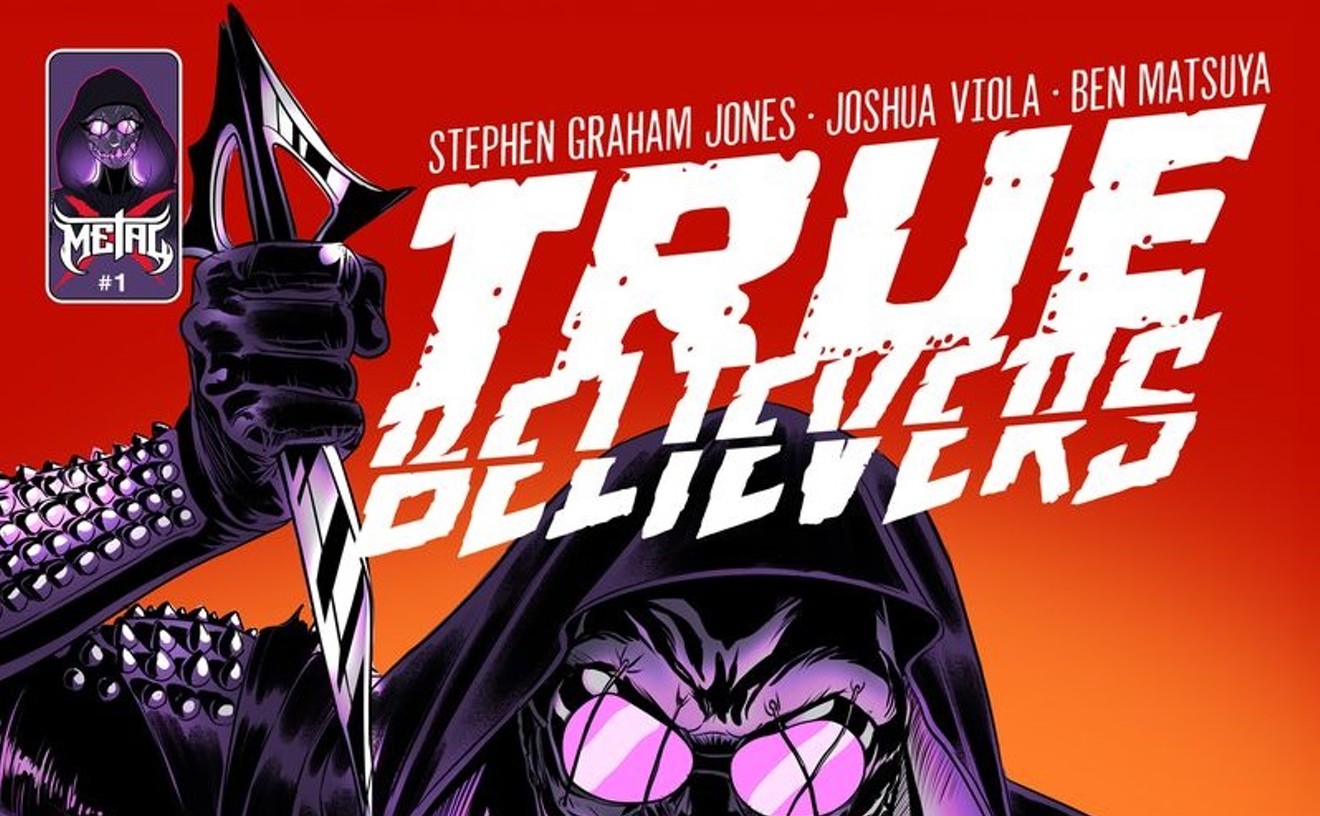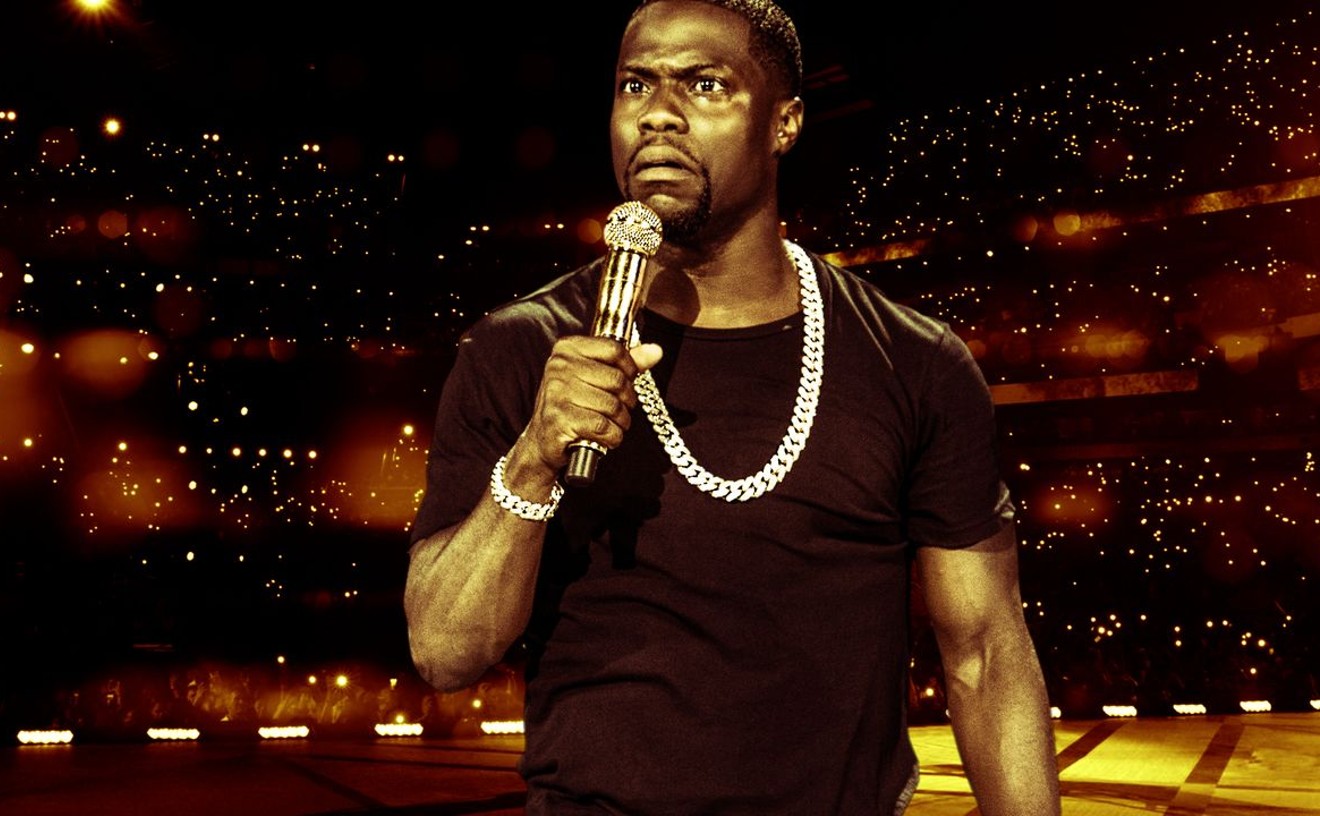There was only one thing to do: get out before I was spotted. Alas, it was too late. As I headed for the door, Kelly came through it and asked, "What do you think of my show?" I gulped hard and tried to think of something polite to say, but he took me off the hook almost immediately by adding, "It's in the back."
Thank God.
I followed Kelly to the Associates' Space, where I was immediately surrounded by urbane abstractions riffing on the style of the mid-twentieth-century transcendentalists who worked in Taos, the artist's home town. As I look back, I'm surprised that my eyes didn't explode from the radical optical adjustment required to shift from the homely and ineptly done brown daubs in the front to the masterfully lyrical compositions done in brilliant colors in the back.
Kelly is still working along these same lines, but he's gotten even better at it, believe it or not. Original + Digital: new work by H. Warren Kelly is, like that first effort, installed in the Associates' Space at Pirate and grew out of the Taos transcendentalist tradition.
The title refers to the fact that Kelly combines traditional one-off methods such as paintings and drawings and puts them together with computer-generated imagery produced in multiples, such as digital prints. The different types of work are stylistically related, though the paintings and drawings are more minimal and are lighter in mood and tone, while the prints are richly dense in both color and detail.
There are only two paintings in the exhibit: "Another Roadside Attraction 1" and the closely associated "Another Roadside Attraction 2." The two works are hung side by side on the west wall, so it's easy to see how similar they are. Both are quite large, and each is crowded with a wide assortment of arching, swirling and looping lines done in an astounding array of vibrant hues on a field of essentially unadorned primed canvas. The lines are meant to convey the landscape around Taos, but you really have to use your imagination to see it: Other than in some kind of bare-bones way, the paintings include no obvious references to the scenes they purportedly depict.
These works have a structural component in the black enamel lines that define their pictorial elements. The lines correspond to the graphite in two drawings, called "Roadside Sketches," that are the preliminary studies for the larger works.
It would be easy to conclude that the paintings and drawings anticipated the digital pieces, but that would be wrong. It was only a couple of weeks ago that Kelly created the drawings and paintings -- long after he'd finished the masters for the prints. Kelly began using computers and high-tech printers because he liked the way his slides looked when scanned and printed out. The digital pieces at Pirate, though, are not simply scanned paintings and drawings. Kelly first creates drawings the old-fashioned way, with pencil and paper. He then refers to those sketches as he "draws" in a newfangled way, using Photoshop and a mouse. "If I simply scanned paintings, there'd be pixelization when I enlarged them," Kelly explains. "This way, the files are so big, there's no pixelizing no matter how big I make them. I start by putting in horizontal lines -- like the lines on a piece of ruled paper -- and then I hang the compositions off them."
For the Pirate show, Kelly has done eleven prints: five from the "Arroyo Seco Theme Park" series and three each from the "El Prado" and "Rinconada" series. The spectacular colors he selects and juxtaposes -- like orange and pink with purple -- are absolutely right on.
Kelly's repetition of the imagery combined with toned-up color schemes seems to be a tip of the hat to late pop-art pioneer Andy Warhol, the most important mentor for cutting-edge contemporary art right now. Warhol strikes me as an unlikely New York-based source of inspiration, considering the Southwestern flavor of Kelly's vision. But there's no denying that this Warholian aspect is the perfect counterpoint to the overriding expressionism of these pictures, giving them a marvelously contemporary feel.
Pirate's back room seems like a weird place to find a display as drop-dead elegant as Kelly's. What makes it even stranger is that Kelly is represented by Denver's + Gallery, so it's a mystery why it wasn't presented there, a much more appropriate venue for it. No matter, Original + Digital is a great show right where it is -- beautiful, intelligent, coherent and completely consistent, with high quality being the hallmark of everything in it. You'd be foolish to miss it -- but hurry, because it comes down this weekend.
Another show that's closing soon and is definitely worth checking out is Jules Olitski: Works on Paper, at Sandy Carson Gallery on Santa Fe Drive. The paintings, drawings and prints in this exhibit are not the kind of thing you'd think of when you hear the name Olitski. The artist became famous for his '60s color-field abstractions, one of several logical extensions of abstract expressionism. His paintings of the time were utterly flat, then a desired attribute, but by the '70s, Olitski was reintroducing depth to his pictures.
Over the years, Olitski has relentlessly experimented, creating work in a huge variety of formalist abstract styles, but nothing represents as much of an aesthetic departure as these new works at Sandy Carson, which are crudely yet luxuriously executed landscapes and seascapes. Despite such a radical change in direction, the new pieces do bear some relationship to his classic work. The backgrounds are handled like color fields, as usual, but on top, Olitski places recognizable objects, especially trees and sailboats -- and that's not usual.
I first saw Olitskis of this type last year in a show at the Singer Gallery of the Mizel Center for Arts and Culture. Then, as now, they reminded me of the style of the visionary nineteenth-century American painter Albert Pinkham Ryder, whose awkward and expressive works were a source for the kind of modernist abstraction that made Olitski famous a generation ago.
Olitski, who is 83, divides his time between homes in Florida and New Hampshire and a studio warehouse in Vermont. William Biety, director of the Sandy Carson Gallery, met the artist in Florida in the 1980s and has remained in contact with him. So when Biety decided to do this show, he was able to visit the Vermont studio and select the pieces he wanted to include.
The exhibit is installed in the front gallery and starts off with a very traditional-looking painting, "Once Upon a Time in Tavernier," done in pastel on rag paper earlier this year. The composition, with its big, gnarly tree up front and sailboats in the middle, resembles a stage. The clouds reinforce this impression because they appear to be a proscenium. In the most abstract of Olitski's works, the composition runs side to side and top to bottom, with no defining framework within the picture, as in the extremely Ryder-ish "Green Sea Passage," which depicts a sailboat, done in black and white, placed in the middle of a field of alternating grays and greens. "Green Sea Passage" is from 2001, making it one of the oldest pieces in the exhibit.
At first the paintings in Jules Olitski struck me as primitive, even childlike, but the longer I looked at them, the more elegant they became. Maybe even sophisticated.
Speaking of sophisticated contemporary art based on the landscape, the artist Christo and his wife, Jeanne-Claude, have resurrected "Over the River," their plan unveiled in 1992 to cover a portion of the Arkansas River in Southern Colorado with canvas panels stretched between the two banks.
Christo became famous in the 1960s for his epic conceptual installations, of which "Over the River" is the latest example. Earlier this year he did his most popular piece ever, "The Gates," in New York's Central Park. This installation of freestanding lintels with pieces of fabric hanging from the cross-members, arranged along a labyrinth of existing park paths, attracted tens of thousands of visitors, who spent nearly $100 million while in the Big Apple.
Christo and Jeanne-Claude were in Colorado last week to describe their proposal to the locals and to get the red tape rolling with regard to county, state and federal permits. The pair would like to pull off "Over the River" in 2008, which sounds like a long time in the future; considering the scope of the project, however, it's actually more like the day after tomorrow. To meet this deadline, the various bureaucrats involved will have to expedite the process, though that seems unlikely. But at least the couple has experience with Colorado rules, having installed "Valley Curtain" across Rifle Gap in 1972.
One legitimate concern about "Over the River" is the environmental impact of both the piece itself, which will need to be anchored into the rock on either side of the river, as well as the many problems associated with thousands of people flocking to a natural environment. On the bright side, the Christo crew are pros, and are thus up to the job of minimizing the negative effects of the piece -- or at least repairing it afterward.
"Over the River" is likely to be Christo's last major work, and I can't wait to see it.










